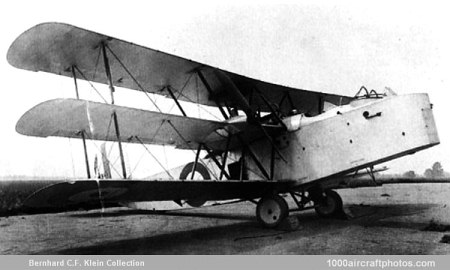Accommodation was provided for a crew of three, the pilot's cockpit ahead of the wing, and in front of the pilot a cockpit for a wireless operator, navigator or gunner, whichever was carried. The fuselage-mounted single 450 hp Napier Lion engine drove two 9 ft 6 in (2.90 m) tractor propellers on the wings through bevel boxes and wing-shafts. Behind the engine was a compartment for the engineer, from where the engine could be started. Swiveling radiators were fitted on the fuselage sides, for maximum cooling these were swung into the flight direction, for minimum cooling they lay against the fuselage sides.
The landing gear was of combined oleo and compression rubber type, and special attention had been paid to handling and steering the machine on the ground. For this purpose the usual tail skid had been replaced by a steerable tail wheel of novel design. For landing on small airfields the tail wheel could be braked, which was adjusted in such a way that the weight on the wheel actuated the brakes. Thus the braking force was always proportional to the load on the wheel, and it was claimed that when properly adjusted no skidding of the wheel could take place. The brakes were connected up to a lever in the pilot's cockpit so as to enable him to release the brakes for taking off and taxiing.
Serialed J6862 the Possum first flew at Filton on July 19, 1923, and made a public appearance at the 1923 Hendon Pageant. A second aircraft, s/n J6863, flew at Yate on April 27, 1925. Despite having proved the practicality of its layout it was regarded as something of a curiosity by the pilots that flew it at Martlesham Heath, where eventually both aircraft were damaged beyond repair while being tested.
Span: 39 ft 0 in (11.89 m)
Length: 46 ft 0 in (14.02 m)
Height: 13 ft 9 in (4.19 m)
Wing area: 777 sq.ft (72.19 sq.m)
Loaded weight: 6,300 lb (2,858 kg)
